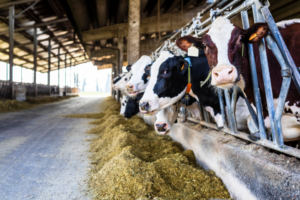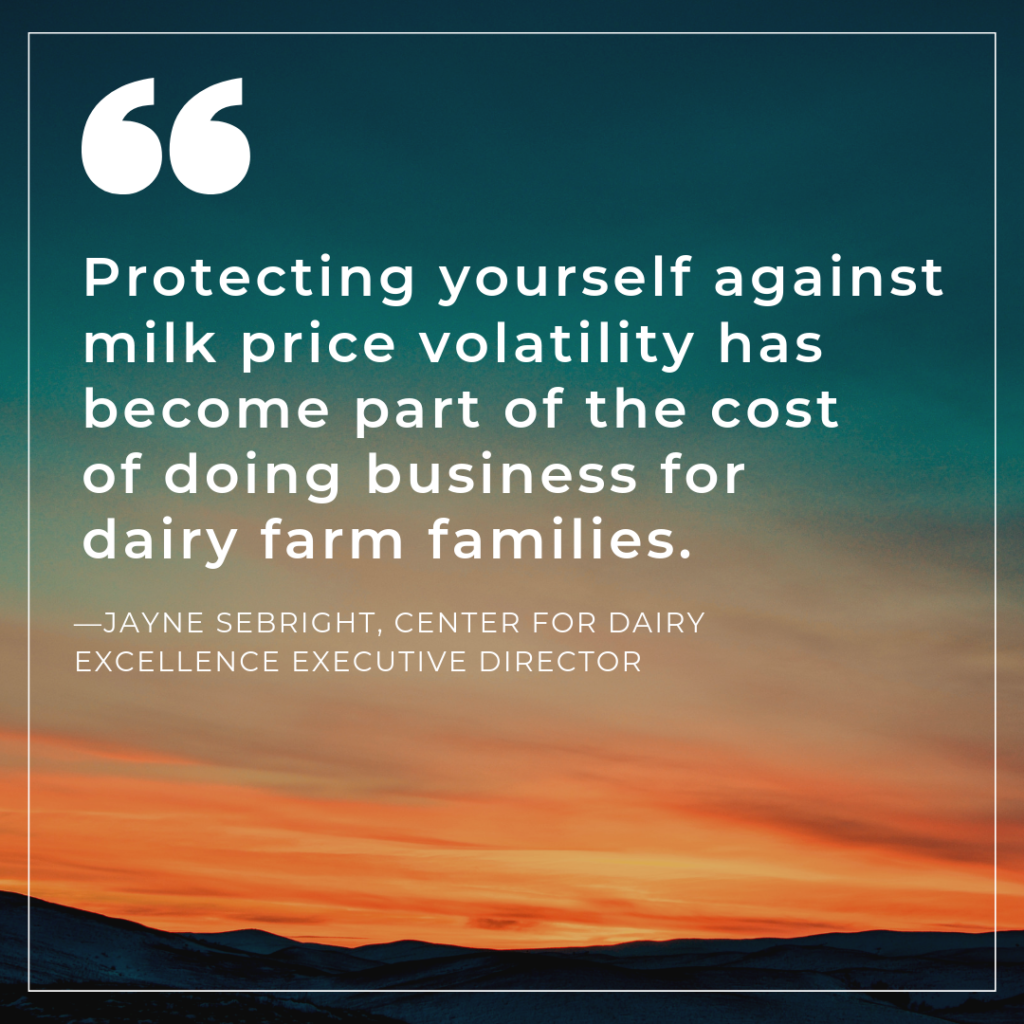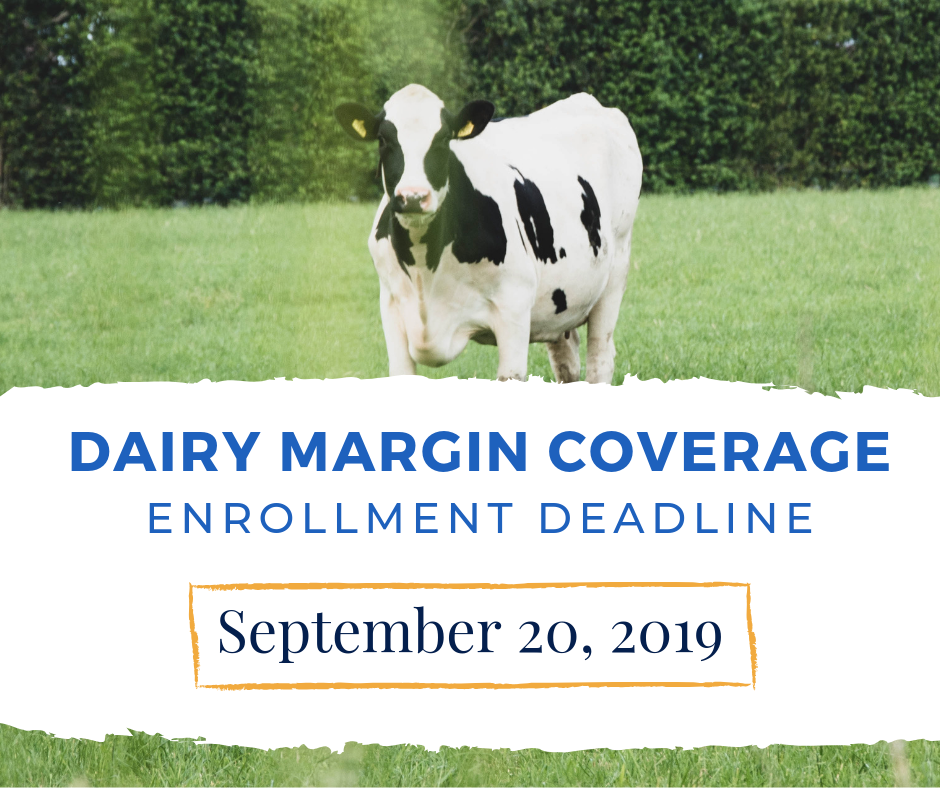
By Jayne Sebright, Center for Dairy Excellence Executive Director
Every time I look at an income statement, I realize just how expensive the cost of doing business can be. When you think about labor, capital and insurance, these items can really eat into your bottom line. But without any one of them, you could be putting yourself at risk and possibly end up losing your business. Take insurance for example.
Recently we sat down to review all the Center for Dairy Excellence’s insurance policies to ensure we had the right level of coverage for what we needed as a small business. When we went over each policy, our insurance agent explained why that policy was necessary and what it would protect us from. When I thought of all the scenarios that could happen – car accidents, employee injuries, theft, injuries at events, etc. — the risk we would have without insurance seemed unsurmountable, especially in today’s climate.
Farmers wouldn’t think of not having fire insurance or auto insurance. Most have workman’s comp or health insurance or both to protect their families and their employees, although it is incredibly expensive. But when it comes to protecting our risk against product losses, that is where we fall short. In a 2017 producer survey conducted by the Center, only 23 percent of the Pennsylvania dairy farm families who completed the survey indicated they use crop insurance to protect themselves against weather disasters or crop failures. Only 14 percent indicated that they use another risk management program to protect themselves against profit losses other than crop insurance.
That’s almost like building a house and not taking out a property-owner’s policy. What if there is a fire or even just a bad storm that takes the roof off or floods the basement? How are you going to cover those losses? Is it any different if a drought or a flood destroys your crops?
On the dairy side, risk management is a little different. You’re not necessarily protecting yourself against production losses as much as you are protecting yourself against decreases in the milk price or increases in your input costs. But the concept is the same –you are protecting yourself against the unknown.

DMC Sets a Bottom
Over the past four years, we have seen significant volatility in the marketplace. It has placed tremendous stress on even the most well-managed dairy farms. The safety net provided in the previous Farm Bill wasn’t adequate to protect farmers from these devastatingly low prices, but legislators recognized its inadequacy and rolled out the Dairy Margin Coverage (DMC) program with the 2018 Farm Bill.
The DMC is a voluntary program administered through the USDA’s Farm Service Agency (FSA) that pays farms when the difference – or the margin – between the national milk price and the average feed costs falls below a certain level selected by the program participant. Margin levels range from $4.00 to $9.50 per hundredweight in this program, with premiums attached to the higher levels. The DMC works much like an insurance program. The farmer pays a premium to lock in a higher margin and receives an indemnity payment when the margin falls below that level.
Under the new program, farmers with a production history of 5 million pounds or less in annual milk production qualify as Tier 1 farms and can receive coverage of up to $9.50. Those with above 5 million pounds in annual production as their production history can receive Tier 1 benefits on their first 5 million pounds but must choose a premium level of between $4 and $8 for production above 5 million pounds at much higher premium levels than what the Tier 1 level offers. In addition to the premium amounts, farms must pay a $100 administration fee annually to participate.
For smaller farms, this program is very affordable. Premium levels are based on coverage levels, with the $9.50 coverage for Tier 1 being available at 15 cents per hundredweight. Farms can also choose to sign up for all five years, saving 25 percent on their premiums but locking themselves into that coverage level (ie: $9.50) for all five years. Sign-ups for the program began on June 17 with payments retroactive to January 1.
Based on current USDA data, the DMC premium for an average Pennsylvania dairy farm for annual enrollment in DMC covering 95 percent of production at the $9.50 margin coverage equals $2,562.40. This year, margins announced for January through June trigger payments for a total amount of $8,577.36 or net payment of $6,014.96 after the premium is paid. If that same producer takes the 25 percent annual premium discount by enrolling at the $9.50 margin for the full five-year term of the 2018 Farm Bill, the total premium each year equals $1,946.80, resulting in a net payment for January through July of $6,630.56.

PA Producers Slow to Enroll
Despite this program having a guaranteed payout in 2019, Pennsylvania dairy farm families have been slow to enroll in it. USDA updates enrollment numbers for the program weekly. As of August 5, 42 percent of the nation’s dairies were enrolled in DMC with estimated payments worth $197 million. In Pennsylvania, only 22 percent of the dairy farms have enrolled in the program, with estimated payments worth over $15 million. Based on the estimated payments, Pennsylvania’s larger dairy farms are enrolling in DMC, but our smaller farms are not— even though the program was specifically designed to be more beneficial to the small to medium-sized (less than 250 cows) dairies.
Milk price volatility will not go away, and unfortunately, protecting yourself against it has become part of the cost of doing business for dairy farm families. DMC is a program that essentially provides a floor to protect your operation against lower milk prices. However, to receive the benefit, you must be enrolled. The deadline to enroll is September 20. If you have not enrolled already, visit your local FSA office today. If you do not, you could be leaving significant money on the table.
Follow along with our Center Focus Column each month.

